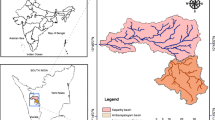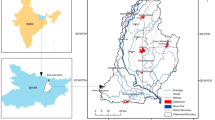Abstract
Digital elevation model (DEM) is one of the input data derived from different satellite sensors for hydrologic and hydraulic modelings. Two prime questions could be answered before using these DEMs. First, the acceptability of datasets for our use and second appropriate resolution of the dataset. Three widely used DEMs SRTM 30m, ASTER 30m and SRTM 90m are analyzed to evaluate their suitability to delineate river network and basin boundary area. The hydrology tool of spatial analyst extension inbuilt in ArcGIS 10.2 (which uses the D8 method for calculation of flow direction) has been used for the delineation of both river networks and basin boundary. The assessment of river network alignment and boundary delineation is carried out in the seven sub-catchments of Gandak river basin having different morphological characteristics. The automatically delineated boundary area for all the three DEMs reflects a significant difference when compared with the digitized basin area from the Ganga flood control commission (GFCC) map. The maximum boundary area delineation error is 39137.20 km2 forASTER 30m, and minimum delineation error of 13239.28 km2 for SRTM 90m. In the stream network, delineation accuracy is good for SRTM 90m while, except Gandak trunk, ASTER 30m DEM shows better delineation accuracy indicated by mean absolute error (MAE) and standard deviation (SD).
Similar content being viewed by others
References
Bravo, J.M., Allasia, D., Paz, A.R., Collischonn, W., Tucci, C.E.M. (2012) Coupled Hydrologic-Hydraulic Modeling of the Upper Paraguay River Basin. Jour. Hydrol. Engg., v.17(5), pp.635–646.
Burrough, P.A. (1986) Principles of Geographical Information Systems for Land Resources Assessment. Clarendon Press, Oxford.
Costa-Cabral, M.C. and Burges, S.J. (1994) Digital Elevation Model Networks (DEMON):A model of flow over hillslopes for computation of contributing and dispersal areas. Water Resour. Res., v.30(6), pp.1805–1815.
Demirel, M.C., Venancio, A. and Kahya, E. (2009) Flow forecast by SWAT model and ANN in Pracana basin, Portugal. Adv. Eng. Softw., v40(7), pp.467–473.
Fairfield, J. and Leymarie, P. (1991) Drainage networks from grid digital elevation models. Water Resour. Res., v.27(5), pp.709–717.
Han, D. and Hammond, M. (2006) Issues of using digital maps for catchment delineation. Proc. ICE - Water Manag., v.159(WMI), pp.45–51.
Jain Sharad, K. (2008) Impact of retreat of Gangotri glacier on the flow of Ganga River. Curr. Sci., v.95(8), pp.1012–1014.
Jenson, S.K. and Domingue, J.O. (1988) Extracting Topographic Structure from Digital Elevation Data for Geographic Information System Analysis. Photogrammatric Engg. Remote Sens., v.54(11), pp.1593–1600.
Maidment, D.R. (2002) Arc Hydro: GIS for water resources. ESRI press, Redlands, CA, pp.203.
Moore, I.D. and Grayson, R.B. (1991) Terrain-based catchment partitioning and runoff prediction using vector elevation data. Water Resour. Res., v.27(6), pp.1177–1191.
O’Callaghan, J.F. and Mark, D.M. (1984) The extraction of drainage networks from digital elevation data. Comput. Vision, Graph. Image Process, v.28, pp.323–344.
Orlandini, S. (2003) Path-based methods for the determination of nondispersive drainage directions in grid-based digital elevation models. Water Resour. Res., v.39(6), pp.1144–1151.
Paiva, R.C.D., Collischonn, W. and Tucci, C.E.M. (2011) Large scale hydrologic and hydrodynamic modeling using limited data and a GIS based approach. Jour. Hydrol., v.406 (3&4), pp.170–181.
Paz, A.R., Brabo, J.M., Allasia, D., W.C. and C.E.M.T. (2010) Large-Scale Hydrodynamic Modeling of a Complex River Network and Floodplains. Jour. Hydrol. Engg., v.15(2), pp.152-165.
Paz, A.R., Da Collischonn, W., Risso, A. and Mendes, C.A.B. (2008) Errors in river lengths derived from raster digital elevation models. Comput. Geosci., v.34(11), 1584–1596.
Pereira-Cardenal, S.J., Riegels, N.D., Berry, P.A.M., Smith, R.G., Yakovlev, A., Siegfried, T.U. and Bauer-Gottwein, P. (2011) Real-time remote sensing driven river basin modeling using radar altimetry. Hydrol. Earth Syst. Sci., v.15(1), pp.241–254.
Pramanik, N., Panda, R.K. and Sen, D. (2009) One Dimensional Hydrodynamic Modeling of River Flow Using DEM Extracted River Cross-sections. Water Resour. Manag., v.24(4), pp.835–852.
Quinn, P., Beven, K., Chevallier, P., Planchon, O. (1991) The prediction of hillslope flow paths for distributed hydrological modelling using digital terrain models. Hydrol. Process, v.5(1), pp.59–79.
Rahman, M.M., Arya, D.S. and Goel, N.K. (2010) Limitation of 90 m SRTM DEM in drainage network delineation using D8 method—A case study in flat terrain of Bangladesh. Appl. Geomatics, v.2(2), pp.49–58.
Seibert, J. and McGlynn, B.L. (2007) A new triangular multiple flow direction algorithm for computing upslope areas from gridded digital elevation models. Water Resour. Res., v.43(4), W04501, doi:10.1029/2006WR 005128
Strahler, A.N. (1952) Hypsometric (Area-Altitude) analysis of erosional topograply. Geol. Soc. Amer. Bull., v.63(11), pp.1117–1142.
SWAT (2012) Soil & Water Assessment Tool. Texas A&M University. Retrieved 1 March 2012.
Tarboton, D.G. (1997) A new method for the determination of flow directions and upslope areas in grid digital elevation models. Water Resour. Res., v.33(2), pp.309–319.
Venkatachalam, P., Krishna Mohan, B., Amit Kotwal, Vikash Mishra, V.M. and M.P. (2001) Automatic Delineation of Watersheds for hydrological applications. 22nd Asian Conferance Remote Sensing, Singapore.
Vladimir, J. Alarcon and Chuck O’Hara (2006) Using IFSAR and SRTM elevation data for watershed delineation. MAPPS/ASPRS 2006 Fall Conf. November 6-10, San Antonio, Texas.
Author information
Authors and Affiliations
Corresponding author
Rights and permissions
About this article
Cite this article
Kumar, B., Patra, K.C. & Lakshmi, V. Error in digital network and basin area delineation using d8 method: A case study in a sub-basin of the Ganga. J Geol Soc India 89, 65–70 (2017). https://doi.org/10.1007/s12594-017-0559-1
Received:
Accepted:
Published:
Issue Date:
DOI: https://doi.org/10.1007/s12594-017-0559-1




